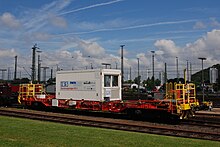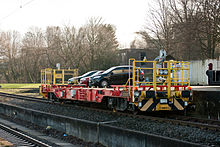CargoSprinter
| 690/691 (CargoSprinter) | |
|---|---|
| Number: | 7 prototypes, 4 of which from Windhoff (690) and 3 from Talbot (691) |
| Manufacturer: | Windhoff Bahn- und Anlagentechnik , Talbot wagon factory |
| Year of construction (s): | 1996 |
| Retirement: | 2004 |
| Axis formula : | (1A) (A1) + 1'1 '+ 1'1' + 1'1 '+ (1A) (A1) (Windhoff) or (1A) (A1) + 2'2'2'2' + ( 1A) (A1) (Talbot) |
| Gauge : | 1435 mm ( standard gauge ) |
| Length over buffers: | 90,360 mm |
| Length: | 20,190 mm (end car) 16,660 mm (middle car) |
| Height: | 2,010 mm |
| Width: | 2,900 mm |
| Empty mass: | 118 t |
| Service mass: | 278 t |
| Top speed: | 120 km / h with a 160 t load |
| Continuous output : | 4 × 265 kW |
| Power transmission: | 6-speed automatic transmission VOLVO Powertronic PT 1650 |
| Number of traction motors: | 4th |
| Drive: | Volvo six cylinder diesel engine |
| Translation levels: | 5 |
| Brake: | Disc brakes |
| Coupling type: | UIC central buffer coupling |
The CargoSprinter (series 690/691) was a freight railcar produced in two designs by Rheiner Windhoff Bahn- und Anlagentechnik and the Aachener Waggonfabrik Talbot (brand name "Talion") for rail freight transport . The multiple units consisted of two powered end cars and three non-motorized intermediate cars (Windhoff) or a three-part non-motorized articulated intermediate car (Talbot).
commitment
In 1995, DB Cargo and the central division Neue Systeme Minden ordered prototypes of container freight cars from Windhoff and Talbot. The first CargoSprinter built by Windhoff was presented on October 9, 1996. The first Talbot set followed on February 27, 1997. A total of seven copies of the freight trains were built (four by Windhoff, three by Talbot).
From 1998 to the beginning of 2000 they were used under the train type IKL as an intercom logistics train in combined traffic for the Hellmann freight forwarder between Hamburg Hohe Schaar and Osnabrück and Cargo City Süd at Frankfurt am Main Airport in the night jump .
The aim was for the vehicles to replace journeys with trucks . You should as individual vehicles, the goods from sidings pick of companies. The trains should then be coupled to form multiple units and then again serve the individual connections separately. Due to the elimination of large shunting movements , they were more flexible and, with a maximum of 120 km / h, faster than conventional freight trains . The maximum payload for a set was 160 t. There were 5 parking spaces, each 50 feet in size. This meant that up to 25 10 'containers , 10 20' containers and 5 40 'containers could be transported. The first prototype drove in 1996, from 1997 the 7 units ran in test operation between Hamburg / Osnabrück via Hannover Hbf (there combined / winged to form 2 units ) to Frankfurt Airport.
At the beginning of 2000 the operation was ended and the trains were parked in Osnabrück. A possible deployment between the Opel plants by the Fiege forwarding company under the name Railrunner was not possible in 2001. The final withdrawal from service took place on May 28, 2004.
However, there were no large-scale use in Germany for various reasons:
- Technical malfunctions in the vehicles - not least due to the serious differences between the two variants - hampered use
- Construction work as part of the Expo 2000 in Hanover caused many delays during test operations
- the vehicles were twice as expensive as originally planned by the manufacturer
- there was hardly any political support for this type of freight transport
- the DB AG changed its Cargo transport concept even during the trial period in favor of other long-range solutions
Whereabouts
In 2002, Siemens and RWTH Aachen University developed two prototypes of their concept for the driverless and automatic “CargoMover” from two end cars of the Cargosprinter . This should be an automatically signal-controlled traction vehicle for single wagon traffic. As part of the conversion work, the Cargosprinter driver's cabs were dismantled. The control technology was laid in boxes that are located above and between the solebars. The project was discontinued in 2005. One of the two converted vehicles was later located in the Siemens test center Wegberg-Wildenrath and was occasionally still used as the "PCW 5" for shunting trips. In the meantime, the vehicle now used as a test vehicle is owned by the RWTH as “IFS 5”. The other vehicle, the "IFS 1" test vehicle, is also owned by the Institute for Rail Vehicles and Transport Systems at RWTH Aachen University and is used there for measurement and test drives. A 20 ft container is set up to accommodate technical equipment and personnel.
At the end of 2003, Deutsche Bahn put its six remaining CargoSprinters up for sale. The vehicles parked in Osnabrück should achieve sales proceeds of at least 250,000 euros.
The three prototypes from Talbot were sold to ÖBB in 2004 . There they were converted into the tunnel rescue trains X690 .002 / 502, X690.003 / 503 and X690.004 / 504 by 2008 . They are stationed on the Tauern Railway in the Böckstein , Mallnitz and Spittal - Millstättersee stations . There, they replaced the 2043 ÖBB -covered breakdown trains .
The locomotives of the tunnel rescue trains are also used for other tasks. X691 001 and X691 503 were on the road in Austria with the MMT TERSUS weed spraying train in May 2020.
Two Talbot railcars (691 002 and 691 502) came to Switzerland at the end of 2008 and, after various adjustments, were used as a cargo shuttle train . A train has been carrying gravel for the construction site of the Zurich cross-city line since April 2009 . A second set has been running for Raillogistics on the Felsberg-Frauenfeld-Härkingen-Dailliens route since June 2009.
Further development

The Windhoff company further developed the concept into a modular vehicle system called a Multi Purpose Vehicle (MPV). This is not primarily designed for container transport, but for special vehicles. For example, as rail cleaning vehicles in a variant adapted to local conditions in Australia and modified in Great Britain. In addition, these vehicles are also used as railway service vehicles and as fire-fighting and rescue trains.
See also
- Windhoff MPV - successor to the CargoSprinter
- JR Freight Class M250 - Container Rail Car in Japan
Web links
swell
- Thomas Estler: Type customer of German diesel multiple units. Transpress, Stuttgart 2004, ISBN 3-613-71238-5
Individual evidence
- ↑ a b Report DB AG wants to sell Cargo-Sprinter . In: Eisenbahn-Revue International , issue 2/2004, ISSN 1421-2811 , p. 59.
- ^ Institute for Rail Vehicles at RWTH Aachen University: Home. Retrieved January 8, 2019 .
- ^ Franz Mairhofer, Gregor Janßen: CargoMover - the driverless "truck on rails". In: EI - Eisenbahningenieur (54) 12/2003. DVV Media, Hamburg, pp. 5-8.
- ↑ Report on the tunnel rescue train in Böckstein . In: Eisenbahn Österreich , issue 3/2012, p. 117.
- ↑ Lokmagazin 7/2020, page 30
- ↑ Windhoff: Modular Vehicle Technology ( Memento of the original of August 30, 2011 in the Internet Archive ) Info: The archive link was automatically inserted and not yet checked. Please check the original and archive link according to the instructions and then remove this notice.



